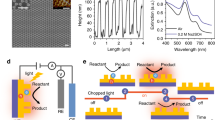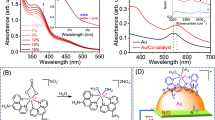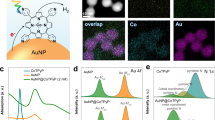Abstract
Plasmonic photocatalysis presents a promising method for light-to-matter conversion. However, most current studies focus on understanding the relative importance of thermal and non-thermal effects while their synergistic effects remained less studied. Here we propose an index, termed overall light effectiveness, to capture the combined impact of these light effects on reactions. By systematic variation of the thickness of catalyst layers, we isolated both thermal and non-thermal contributions and optimized them to achieve maximum light enhancement. We demonstrate the approach using a carbon dioxide hydrogenation reaction on titania-supported rhodium nanoparticles as a model reaction system. It shows a generalizable potential in the design of catalyst systems with optimum combinations of heating and light illumination, especially with broadband light illumination such as sunlight, for achieving the most economical light-to-matter conversion in plasmonic catalysis.

This is a preview of subscription content, access via your institution
Access options
Access Nature and 54 other Nature Portfolio journals
Get Nature+, our best-value online-access subscription
$29.99 / 30 days
cancel any time
Subscribe to this journal
Receive 12 digital issues and online access to articles
$119.00 per year
only $9.92 per issue
Buy this article
- Purchase on Springer Link
- Instant access to full article PDF
Prices may be subject to local taxes which are calculated during checkout




Similar content being viewed by others
Data availability
The data that support the findings of this paper are included in this manuscript and the Source Data. Data are also available from the corresponding author upon reasonable request. Source Data are provided with this paper.
References
Fujishima, A. & Honda, K. Electrochemical photolysis of water at a semiconductor electrode. Nature 238, 37–38 (1972).
Dong, H. et al. An overview on limitations of TiO2-based particles for photocatalytic degradation of organic pollutants and the corresponding countermeasures. Water Res. 79, 128–146 (2015).
Kazuhito, H., Hiroshi, I. & Akira, F. TiO2 photocatalysis: a historical overview and future prospects. Jpn. J. Appl. Phys. 44, 8269 (2005).
Yan, H. et al. Increasing quantum efficiency of polymer solar cells with efficient exciton splitting and long carrier lifetime by molecular doping at heterojunctions. ACS Energy Lett. 4, 1356–1363 (2019).
Zhang, X. et al. Plasmon-enhanced catalysis: distinguishing thermal and nonthermal effects. Nano Lett. 18, 1714–1723 (2018).
Candish, L. et al. Photocatalysis in the life science industry. Chem. Rev. 122, 2907–2980 (2021).
Zhang, Y. et al. Surface-plasmon-driven hot electron photochemistry. Chem. Rev. 118, 2927–2954 (2018).
Bonn, M. et al. Phonon- versus electron-mediated desorption and oxidation of CO on Ru(0001). Science 285, 1042–1045 (1999).
Linic, S., Christopher, P. & Ingram, D. B. Plasmonic-metal nanostructures for efficient conversion of solar to chemical energy. Nat. Mater. 10, 911–921 (2011).
Marimuthu, A., Zhang, J. & Linic, S. Tuning selectivity in propylene epoxidation by plasmon mediated photo-switching of Cu oxidation state. Science 339, 1590–1593 (2013).
Mukherjee, S. et al. Hot electrons do the impossible: plasmon-induced dissociation of H2 on Au. Nano Lett. 13, 240–247 (2013).
Clavero, C. Plasmon-induced hot-electron generation at nanoparticle/metal-oxide interfaces for photovoltaic and photocatalytic devices. Nat. Photonics 8, 95–103 (2014).
Kale, M. J., Avanesian, T. & Christopher, P. Direct photocatalysis by plasmonic nanostructures. ACS Catal. 4, 116–128 (2013).
Mukherjee, S. et al. Hot-electron-induced dissociation of H2 on gold nanoparticles supported on SiO2. J. Am. Chem. Soc. 136, 64–67 (2014).
Brongersma, M. L., Halas, N. J. & Nordlander, P. Plasmon-induced hot carrier science and technology. Nat. Nanotechnol. 10, 25–34 (2015).
Linic, S., Aslam, U., Boerigter, C. & Morabito, M. Photochemical transformations on plasmonic metal nanoparticles. Nat. Mater. 14, 567–576 (2015).
Robatjazi, H., Bahauddin, S. M., Doiron, C. & Thomann, I. Direct plasmon-driven photoelectrocatalysis. Nano Lett. 15, 6155–6161 (2015).
Dubi, Y., Un, I. W. & Sivan, Y. Thermal effects – an alternative mechanism for plasmon-assisted photocatalysis. Chem. Sci. 11, 5017–5027 (2020).
Li, X., Everitt, H. O. & Liu, J. Synergy between thermal and nonthermal effects in plasmonic photocatalysis. Nano Res. 13, 1268–1280 (2020).
Dubi, Y. & Sivan, Y. ‘Hot’ electrons in metallic nanostructures—non-thermal carriers or heating? Light Sci. Appl. 8, 89 (2019).
Dubi, Y., Un, I.-W. & Sivan, Y. Distinguishing thermal from nonthermal (‘hot’) carriers in illuminated molecular junctions. Nano Lett. 22, 2127–2133 (2022).
Sivan, Y. & Dubi, Y. Recent developments in plasmon-assisted photocatalysis—a personal perspective. Appl. Phys. Lett. 117, 130501 (2020).
Dubi, Y., Un, I. W., Baraban, J. H. & Sivan, Y. Distinguishing thermal from non-thermal contributions to plasmonic hydrodefluorination. Nat. Catal. 5, 244–246 (2022).
Li, X., Zhang, X., Everitt, H. O. & Liu, J. Light-induced thermal gradients in ruthenium catalysts significantly enhance ammonia production. Nano Lett. 19, 1706–1711 (2019).
Li, X., Everitt, H. O. & Liu, J. Confirming nonthermal plasmonic effects enhance CO2 methanation on Rh/TiO2 catalysts. Nano Res. 12, 1906–1911 (2019).
Ma, R., Sun, J., Li, D. H. & Wei, J. J. Review of synergistic photo-thermo-catalysis: mechanisms, materials and applications. Int. J. Hydrog. Energy 45, 30288–30324 (2020).
Li, J. et al. Sunlight induced photo-thermal synergistic catalytic CO2 conversion via localized surface plasmon resonance of MoO3−x. J. Mater. Chem. 7, 2821–2830 (2019).
Kamal, K. M. et al. Synergistic enhancement of photocatalytic CO2 reduction by plasmonic Au nanoparticles on TiO2 decorated N-graphene heterostructure catalyst for high selectivity methane production. Appl. Catal. B 307, 121181 (2022).
Zhou, L. et al. Quantifying hot carrier and thermal contributions in plasmonic photocatalysis. Science 362, 69–72 (2018).
Kohno, Y. et al. Photo-enhanced reduction of carbon dioxide with hydrogen over Rh/TiO2. J. Photochem. Photobiol. A Chem. 126, 117–123 (1999).
Christopher, P., Xin, H., Marimuthu, A. & Linic, S. Singular characteristics and unique chemical bond activation mechanisms of photocatalytic reactions on plasmonic nanostructures. Nat. Mater. 11, 1044–1050 (2012).
Kale, M. J., Avanesian, T. & Christopher, P. Direct photocatalysis by plasmonic nanostructures. ACS Catal. 4, 116–128 (2014).
Bakanov, A., Toropov, N. & Vartanyan, T. Optical properties of planar nanostructures based on semiconductor quantum dots and plasmonic metal nanoparticles. Opt. Spectrosc. 120, 477–481 (2016).
Un, I. W., Dubi, Y. & Sivan, Y. Photothermal nonlinearity in plasmon-assisted photocatalysis. Nanoscale 14, 5022–5032 (2022).
Garnett, J. M. Colours in metal glasses, in metallic films, and in metallic solutions.—II. Philos. Trans. Math. Phys. Eng. Sci. 205, 237–288 (1906).
DeVore, J. R. Refractive indices of rutile and sphalerite. J. Opt. Soc. Am. 41, 416–419 (1951).
Rakić, A. D. Algorithm for the determination of intrinsic optical constants of metal films: application to aluminum. Appl. Opt. 34, 4755–4767 (1995).
Zhan, C., Moskovits, M. & Tian, Z.-Q. Recent progress and prospects in plasmon-mediated chemical reaction. Matter 3, 42–56 (2020).
Ou, W. et al. Plasmonic metal nanostructures: concepts, challenges and opportunities in photo-mediated chemical transformations. iScience 24, 101982 (2021).
Amendola, V., Pilot, R., Frasconi, M., Maragò, O. M. & Iatì, M. A. Surface plasmon resonance in gold nanoparticles: a review. J. Condens. Matter Phys. 29, 203002 (2017).
Weick, G., Ingold, G.-L., Jalabert, R. A. & Weinmann, D. Surface plasmon in metallic nanoparticles: renormalization effects due to electron-hole excitations. Phys. Rev. B 74, 165421 (2006).
Khurgin, J. B. Fundamental limits of hot carrier injection from metal in nanoplasmonics. Nanophotonics 9, 453–471 (2020).
Sun, J.-P. et al. Influence of the temperature-dependent dielectric constant on the photoacoustic effect of gold nanospheres. Phys. Chem. Chem. Phys. 24, 29667–29682 (2022).
He, W., Huang, X., Ma, X. & Zhang, J. Significant temperature effect on the LSPR properties of noble metal nanoparticles. J. Opt. 51, 142–153 (2022).
Geng, Z., Yu, Y. & Liu, J. Broadband plasmonic photocatalysis enhanced by photothermal light absorbers. J. Phys. Chem. C Nanomater. Interfaces 127, 17723–17731 (2023).
Acknowledgements
This work was supported by a grant from the National Science Foundation (no. CHE-1954838); the fund was used to support graduate students (Z.G. and Y.Y.) and access chemical supplies. Some characterizations were performed at the Duke University Shared Materials Instrumentation Facility, a member of the North Carolina Research Triangle Nanotechnology Network, which is supported by the National Science Foundation (award no. ECCS-2025064) as part of the National Nanotechnology Coordinated Infrastructure. We also thank H. O. Everitt from Army Research Laboratory-South for insightful discussions on this topic in general.
Author information
Authors and Affiliations
Contributions
J.L. conceived and supervised the research project. Z.G. and Y.Y. designed the experiments and carried out photocatalytic tests. Y.Y. fabricated photocatalysts and carried out SEM and X-ray photo-electron spectrometry characterization. Z.G. performed TEM characterization. A.J.O. contributed to the conceptual discussion and performed some of the initial experiments. Z.G. and Y.Y. analysed the results and wrote and revised the paper with input from the other authors.
Corresponding author
Ethics declarations
Competing interests
The authors declare no competing interests.
Peer review
Peer review information
Nature Catalysis thanks Vivek Polshettiwar and the other, anonymous, reviewer(s) for their contribution to the peer review of this work.
Additional information
Publisher’s note Springer Nature remains neutral with regard to jurisdictional claims in published maps and institutional affiliations.
Supplementary information
Supplementary Information
Supplementary Figs. 1–7.
Source data
Source Data Figs. 1–4.
Statistical Source Data for Figs. 1–4.
Rights and permissions
Springer Nature or its licensor (e.g. a society or other partner) holds exclusive rights to this article under a publishing agreement with the author(s) or other rightsholder(s); author self-archiving of the accepted manuscript version of this article is solely governed by the terms of such publishing agreement and applicable law.
About this article
Cite this article
Geng, Z., Yu, Y., Offen, A.J. et al. Achieving maximum overall light enhancement in plasmonic catalysis by combining thermal and non-thermal effects. Nat Catal 6, 1241–1247 (2023). https://doi.org/10.1038/s41929-023-01045-9
Received:
Accepted:
Published:
Issue Date:
DOI: https://doi.org/10.1038/s41929-023-01045-9



